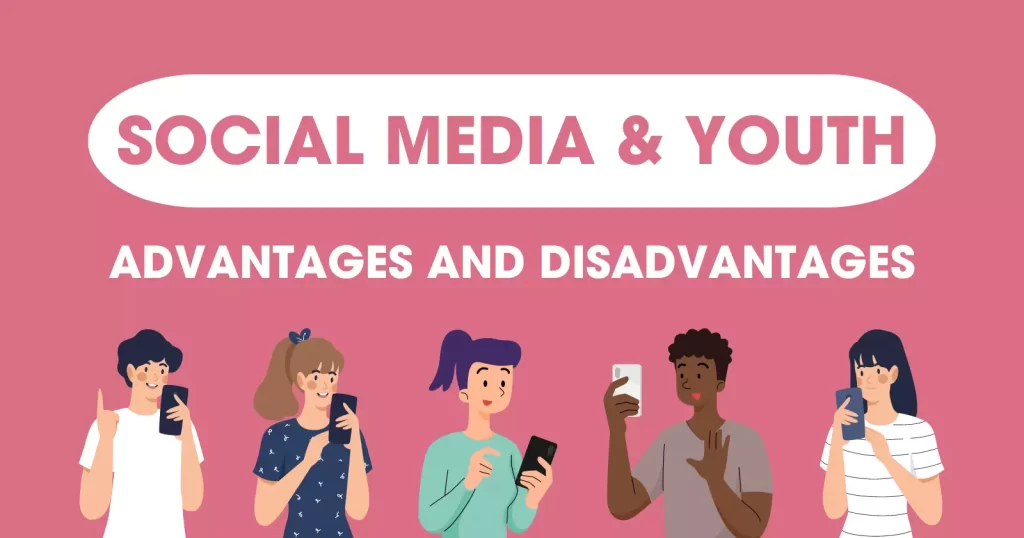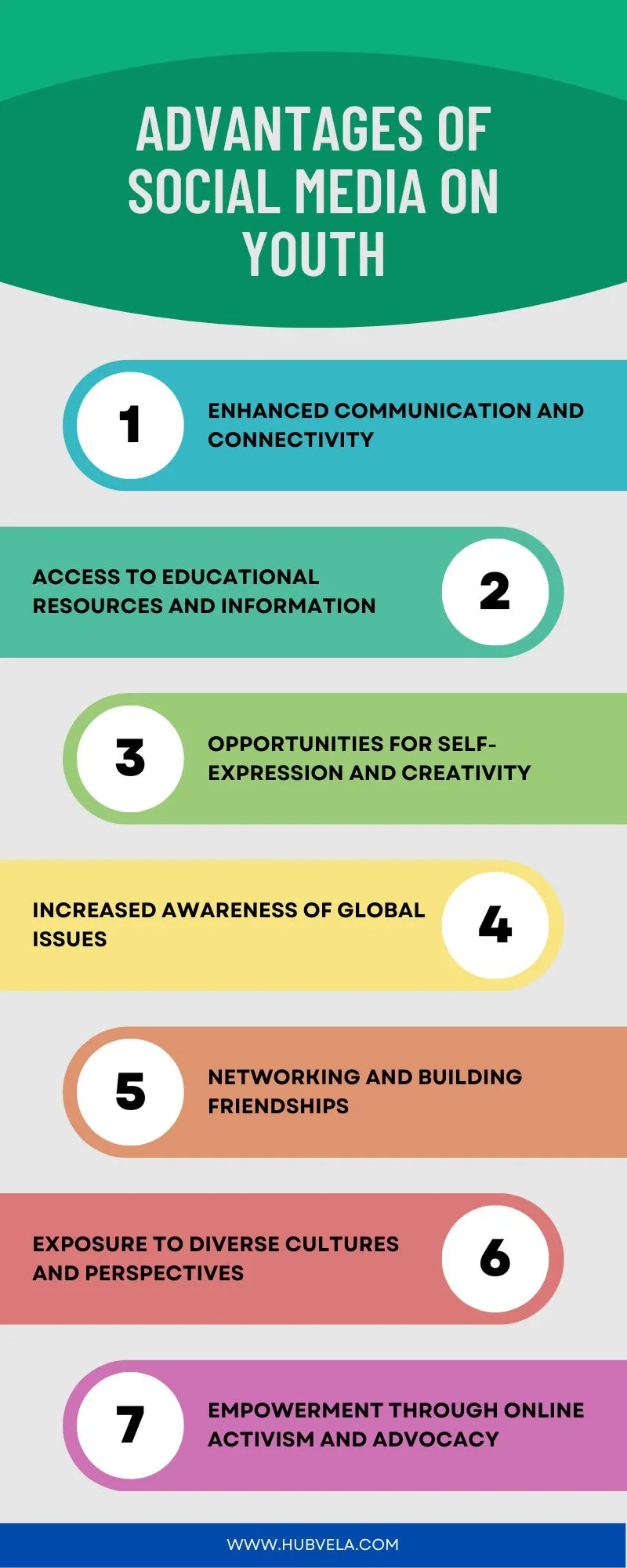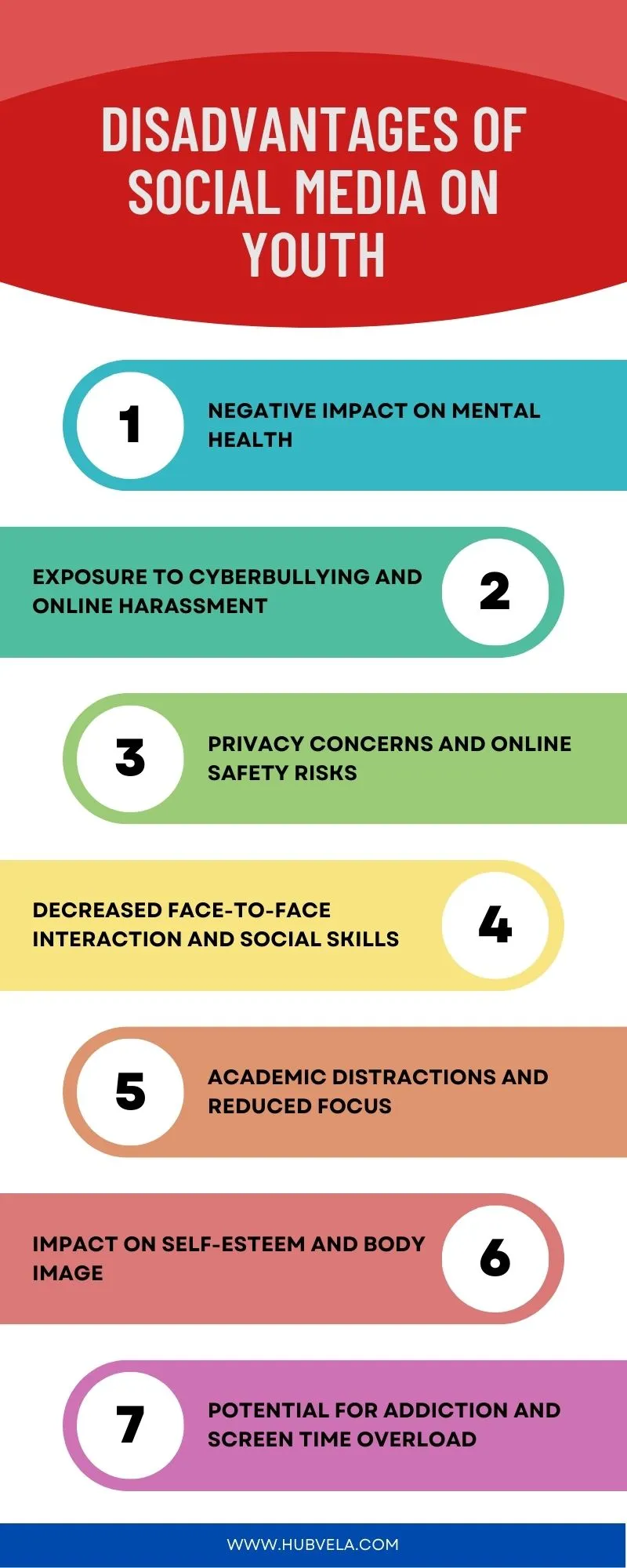Social media has become an integral part of our daily lives, especially for the younger generation. While it has many benefits, there are also some drawbacks that need to be considered.
In this article, we will explore the advantages and disadvantages of social media on youth. Social media platforms allow young people to connect with others from around the world, share their interests, and develop relationships with family and friends.
They can also use social media to showcase their talents, boost their creativity, and learn about the latest trends and technologies.
However, social media can also have negative effects on young people, such as decreased face-to-face communication skills, cyberbullying, and exposure to inappropriate content.

--Advertisement--
Advantages of Social Media on Youth
Social media has become an integral part of the lives of young people today. While there are concerns about the potential risks associated with social media use, such as exposure to inappropriate content, cyberbullying, and privacy issues, there are also many advantages that social media can offer to young people.
We will explore some of the benefits of social media for youth.

1. Enhanced Communication and Connectivity
Enhanced communication and connectivity are some of the most significant advantages of social media for youth. Social media platforms provide an opportunity for young people to connect with their peers, family, and friends from different parts of the world.
They can share their experiences, thoughts, and ideas with others, which helps them to build stronger relationships. Social media also provides a platform for young people to communicate with people who share similar interests and hobbies.
This can lead to the formation of online communities that can provide support and encouragement to young people.
Additionally, social media platforms provide an opportunity for young people to learn about different cultures and perspectives, which can help them become more tolerant and accepting of others.
Social media has enhanced communication and connectivity among young people, which has had a positive impact on their social and emotional well-being.
2. Access to Educational Resources and Information
Access to educational resources and information is one of the advantages of social media for youth. Social media platforms offer many different ways to be used in the classroom, from sharing announcements to holding live lectures, and so much more.
Teachers can use social media platforms like Pinterest to prepare and organize resources, lesson plans, and worksheets for their classes in one place.
Social media also provides a smoother, more direct communication tool between students, teachers, and parents, who can check in and ask or respond to questions.
Social media allows for more e-learning opportunities as well, which is becoming more important as remote jobs and online classes are becoming more popular.
However, it is important to note that teenagers need support and education to develop the skills to manage their social media use.
Parents and teachers should talk with their children about their social media use and set family rules, including consequences for too much use or inappropriate use and whether they will be monitoring their online activities.
3. Opportunities for Self-Expression and Creativity
Social media provides a platform for young people to express themselves and showcase their creativity. Through social media, young people can share their thoughts, ideas, and opinions with a wider audience.
They can also use social media to showcase their talents, such as music, art, and writing. Social media platforms like Instagram, YouTube, and TikTok have become popular among young people who use them to share their creative works with others.
Social media also allows young people to connect with like-minded individuals and form communities around shared interests, which can further encourage self-expression and creativity.
Social media provides young people with a unique opportunity to express themselves and showcase their creativity to a wider audience.
4. Increased Awareness of Global Issues
Increased awareness of global issues is one of the advantages of social media for youth. According to a Pew Research Center survey, a median of 77% across 19 countries surveyed say social media is an effective way to raise public awareness about sociopolitical issues.
Social media can generate awareness, build communities, unite ideas, and share narratives, serving as a communication tool for social justice.
Social media can create public awareness around issues in the name of social justice, empowering communities to organize in the real world around a cause.
Social media also exposes the youth to a range of topics and cultures, giving a voice to those who are underrepresented in society.
Social media well-covers global events, making people more aware of their surroundings and serving as a channel for information, thus paving the way to innovation and success via developing their knowledge and abilities.
5. Networking and Building Friendships
Networking and building friendships are important aspects of social media for youth. Social media platforms provide a venue for interaction and conversation among young people, allowing them to connect with new friends and get to know them better.
In fact, a significant number of teens have met new friends online, with social media and online gameplay being common digital venues for making new connections.
These friendships formed through social media can extend beyond the traditional boundaries of school, neighborhood, or playing field. Social media allows teens to stay connected with their friends, share interests, and explore their identities.
It also provides opportunities for collaboration, idea sharing, and getting feedback, which can be valuable in maintaining professional relationships.
Social media serves as a tool for youth to expand their social networks, foster new friendships, and enhance their social and creative lives.
6. Exposure to Diverse Cultures and Perspectives
Social media has the potential to expose youth to diverse cultures and perspectives, which can be a significant advantage. According to a study by Joseph Kahne et al., online media practices can influence exposure to diverse perspectives.
Social media platforms have allowed people of different backgrounds to reach out and share what they know, giving us a glimpse of the lives of people from different cultures.
The more people you are exposed to, the more opportunities you have to learn about different cultures, values, and belief systems. This can lead to better cultural awareness and empathy, which is how social media has been most powerful.
However, there have been concerns that global media, including globalized social media, may have a homogenizing effect on global culture, in addition to contributing to the marginalization of minority cultures.
This is a concept that has been highlighted by various cultures. There is also professional literature exploring how social media can be utilized specifically for magnifying minority cultures, in ways that weren’t previously available.
It is not a stretch, based on this research, that there may be significant discomfort and hesitation for some individuals from minority cultures when accessing social media platforms – something that Caucasian users largely do not face.
Social media can be a powerful tool for exposing youth to diverse cultures and perspectives. It can lead to better cultural awareness and empathy, which is how social media has been most powerful.
However, there are also concerns that social media may have a homogenizing effect on global culture and contribute to the marginalization of minority cultures.
It is important to recognize these issues and work towards using social media in a way that promotes diversity and inclusivity.
7. Empowerment through Online Activism and Advocacy
Social media platforms provide a space for young people to engage in online activism and advocacy, allowing them to raise awareness about important issues and connect with like-minded individuals from around the world.
Through social media, young people can share their opinions and experiences, and mobilize others to take action on issues that matter to them.
This can lead to a sense of empowerment and agency, as young people feel that they are making a difference and contributing to positive change in their communities and beyond.
Social media can be a powerful tool for youth to engage in activism and advocacy, and to have their voices heard on a global scale.
Disadvantages of Social Media on Youth
Social media has become an integral part of our daily lives, especially for the youth. It has created a greater avenue for people to interact across the globe, allowing teenagers to use it for entertainment, self-expression, and to stay informed about current events.
However, the excessive use of social media can have negative effects on the youth’s overall well-being if not monitored or restricted.
We will discuss the disadvantages of social media on youth, including its potential risks, negative effects, and impact on academic performance.

1. Negative Impact on Mental Health
The negative impact of social media on youth’s mental health is a growing concern. Excessive use of social media can lead to various mental health issues, including depression, anxiety, and low self-esteem.
Cyberbullying is a prevalent problem on social media platforms, which can further contribute to negative mental health outcomes.
The constant exposure to carefully curated and unrealistic portrayals of others’ lives can lead to feelings of inadequacy and comparison, exacerbating mental health issues.
Additionally, the addictive nature of social media can disrupt sleep patterns, leading to fatigue and decreased well-being.
It is important for parents, educators, and young people themselves to be aware of these potential negative effects and promote healthy social media habits and digital well-being.
2. Exposure to Cyberbullying and Online Harassment
Exposure to cyberbullying and online harassment is a significant disadvantage of social media for youth. Cyberbullying involves using electronic communication to harass, threaten, embarrass, or target another person.
Social media platforms provide a space where individuals can be targeted by cyberbullies, who may send mean texts, post hurtful messages, or spread rumors online.
The effects of cyberbullying can be severe, leading to depression, anxiety, and in some cases, even suicide. Cyberbullying can also be anonymous, leaving victims with little recourse to report the bully or seek help.
Additionally, social media allows incidents of bullying to reach a wide audience within a short period of time, potentially causing embarrassment and lasting emotional harm.
It is crucial to educate youth about the risks of cyberbullying and provide support systems to address and prevent such behavior.
3. Privacy Concerns and Online Safety Risks
Social media has become an integral part of daily life for most teens, but it carries risks of being exposed to inappropriate or distressing content, such as aggressive, violent, or sexual comments.
Social media sites are seen as being very ‘cool’ by children and they may be pressured by their friends into joining them. Exposure to inappropriate advertising online is one of the many risks that parents, youth advocates, and policymakers are concerned about.
Risks include exposure to inappropriate content, cyberbullying, and privacy and data breaches. Privacy concerns and online safety risks are among the key issues that relate to teens’ privacy practices and risks to their online safety.
Teens are sharing more information about themselves on social media sites than they did in the past.
For the five different types of personal information that were measured in both 2006 and 2012, each is significantly more likely to be shared by teen social media users in the most recent survey.
Close to half of online teens have said they were older in order to access a website or online service.
Sharing personal information with strangers, cyberbullying, being exposed to too much-targeted advertising and marketing, and being exposed to data breaches are some of the risks associated with social media use.
Parents can help their children stay safe on social media by discussing various scenarios and helping them understand what kind of information should not be shared via social media.
Children can protect their privacy by not sharing personal information like phone numbers, location, and date of birth with strangers online, or with people they don’t know personally.
They should also not add personal details like phone numbers or date of birth to private profiles and log out after using public computers.
4. Decreased Face-to-Face Interaction and Social Skills
Social media has become a ubiquitous part of modern life, and while it has many benefits, it also has some disadvantages, particularly for young people.
One of the most significant disadvantages is the decreased face-to-face interaction and social skills that can result from heavy social media use.
According to a Penn State researcher, social media can change the way brains form new social relationships, maintain current ones, and participate in social groups.
Social media lacks face-to-face contact that allows people to pick up nonverbal cues, such as smiling, arms crossing, and body positioning, that help people communicate. As a result, people have adapted to compensate when communicating.
Excessive use of social media can also cause users to lose their verbal and interpersonal communication skills, resulting in a feeling of isolation.
People tend to rely more on technology than on people, which increases the value one puts on social media versus the value put on intimate friendships.
The verbal and nonverbal indications associated with face-to-face interactions are more intimate, and these social cues can only become natural through constant physical interaction.
Moreover, social media can lead to a loss of social skills, as frequent virtual interactions through social media lack emotion, and when coming face-to-face with a person, frequent users of social media may miss some social cues.
According to a survey of almost 17,000 people from 18 countries, one-third of people communicate with parents, friends, and partners less in the real world because they connect on social media.
Social media has many benefits, but it can also have some disadvantages, particularly for young people. One of the most significant disadvantages is the decreased face-to-face interaction and social skills that can result from heavy social media use.
It is essential to be aware of these potential negative effects and to take steps to mitigate them, such as limiting social media use and prioritizing face-to-face interactions.
5. Academic Distractions and Reduced Focus
Social media can be a significant source of distraction for teenagers, which can negatively impact their academic performance and grades.
According to a research study by the Pew Research Center, 72% of students frequently or occasionally view their social media platform notifications while completing their schoolwork or studying.
Adolescents who spend more time using social media may experience an increased state of online vigilance and preoccupation with social media, leading to more difficulties focusing and sustaining attention.
Furthermore, teenagers who are used to scrolling through social media every few minutes may find it challenging to focus on anything for an extended period.
The distraction caused by social media can be a drawback, especially for teens who are still learning self-control and time management.
Social media may significantly divert teens’ attention from demanding responsibilities like academics or extracurricular activities, making them much less productive and affecting their academic performance.
Social media can also distract teenagers from real-life interactions, such as homework, sleep, and time with friends and family.
Social media can be a significant source of distraction for teenagers, which can negatively impact their academic performance and grades.
While social media has many advantages, such as maintaining friendships and finding new interests, it is essential to reduce its negative effects by limiting social media use and developing self-control and time management skills.
6. Impact on Self-Esteem and Body Image
Social media has been found to have a negative impact on the self-esteem and body image of young people.
Exposure to images of celebrities, fashion or fitness models, and peers on social media can lead to the internalization of beauty ideals that are unattainable for most people, resulting in greater dissatisfaction with body weight and shape.
A positive correlation has been observed between the frequency of social media use and dissatisfaction with body image and low self-esteem.
Millions of teenagers worry about their body image, and images on social media are identified as a key factor that makes them worry about their body image.
Many students have reported that social media has been detrimental to the way they feel about their looks, and they struggle not to compare themselves to the people they see online.
A survey found that Snapchat, Facebook, Twitter, and Instagram all led to increased feelings of depression, anxiety, poor body image, and loneliness.
One of the primary ways social media negatively impacts a teen’s body image is by driving them to compare themselves against others, leading to feelings of shame, insecurity, and poor self-esteem.
However, reducing social media use can significantly improve body image in teens and young adults.
A brief, four-week intervention using screentime trackers showed that reducing social media use yielded significant improvements in appearance and weight esteem in distressed youth with heavy social media use.
Therefore, reducing social media use is a feasible method of producing a short-term positive effect on body image among a vulnerable population of users and should be evaluated as a potential component in the treatment of body-image-related disturbances.
Parents can also help their children maintain a healthy body image in the age of social media by encouraging them to focus on their strengths and positive qualities, rather than their appearance, and by modeling healthy social media use themselves.
7. Potential for Addiction and Screen Time Overload
Social media has become an integral part of the lives of many young people, but it also has its disadvantages. One of the potential negative effects of social media on youth is the risk of addiction and screen time overload.
Spending too much time staring at screens can have negative effects on physical and mental health. Just like tobacco and alcohol use, screen time can become an addiction that can damage health and relationships if it’s not kept in check.
A study from the University of Pennsylvania showed that using Facebook, Snapchat, and Instagram can increase a person’s feelings of loneliness and depression.
Much research has discovered how habitual social media use may lead to addiction and negatively affect adolescents’ school performance, social behavior, and mental health.
Young people making social media posts and browsing any social media site are more susceptible to social media addiction.
Addiction to online social networking, as well as Internet addiction in general, are recent and insufficiently investigated phenomena, frequently discussed and debated in the scientific literature.
Excessive screen time can also lead to sleep deprivation, which can negatively impact mental health. Teenagers are particularly vulnerable to the negative effects of social media as they are still in their developmental years.
This age group is also vulnerable to feelings of social isolation and depression from the social comparison that social media fosters.
An addiction to social media may lead young adults to struggle to engage with others on a normal level, as well as affect their academic performance and chances for a future.
Parents should be aware of the amount of time their teenagers spend on social media and take immediate action if they notice unhealthy behavior such as cyberbullying or sexting.
Conclusion on Advantages and Disadvantages of Social Media on Youth
In conclusion, the impact of social media on youth has both positive and negative aspects. It provides a platform for communication, connection, and self-expression. Social media allows young people to interact with others, explore their identities, and stay connected with friends.
It can also be a source of information and educational resources. However, excessive use of social media can have detrimental effects on mental health, such as cyberbullying, body image issues, and inadequate sleep.
It can also lead to addiction, poor study habits, and a disconnection from reality. It is important for individuals, especially young people, to carefully examine the pros and cons of social media and find a balance in its usage.


